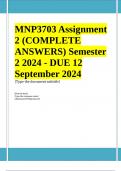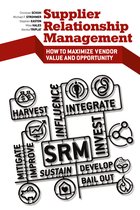MNP3703 Assignment
2 (COMPLETE
ANSWERS) Semester
2 2024 - DUE 12
September 2024
[Type the document subtitle]
[Pick the date]
[Type the company name]
tabbymwesh59@gmail.com
, MNP3703 Assignment 2 (COMPLETE ANSWERS)
Semester 2 2024 - DUE 12 September 2024
Course
Supplier Relationship Management (MNP3703)
Institution
University Of South Africa (Unisa)
Book
Supplier Relationship Management
MNP3703 Assignment 2 (COMPLETE ANSWERS) Semester 2 2024 - DUE
12 September 2024 ; 100% TRUSTED Complete, trusted solutions and
explanations. For assistance, Whats-App 0.6.7-1.7.1-1.7.3.9. Ensure your
success with us... Question 1 The Cox Supplier Relationship Model is based
on two theories – the Transaction-based theory (TBT) and the Resource-
based theory (RBT). Using the model, analyse the elements of the RBT -
corporate architecture, innovation, and reputation - to demonstrate its
contribution to Caterpillar Inc. (CAT) and Barloworld Equipment’s competitive
advantage within the industrial equipment and services industry, particularly in
the context of their operations in southern Africa. (3 marks) Rubric: EXCEEDS
STANDARD (3 marks) MEETS STANDARD (2 marks) BELOW STANDARD
(1 mark) UNSATISFACTORY (0 marks) Question 1 Analyse the elements of
the RBT - corporate architecture, innovation, and reputation to demonstrate its
contribution to their competitive advantage within the industrial equipment and
services industry. Clearly demonstrates the contribution of the RBT elements
to the competitive advantage of CAT and Barloworld Equipment within the
industrial equipment and services industry, specifically in their operations in
southern Africa. OR Discusses theory and provides specific examples from
the case study, illustrating in great detail how the contribution adds to the
partnership's strengths in each element, giving them a competitive edge.
Discuss all RBT elements that contribute to CAT and Barloworld Equipment’s
competitive advantage, but is not specific to the industrial equipment and
services industry. OR Discuss all RBT elements that contribute to CAT and





